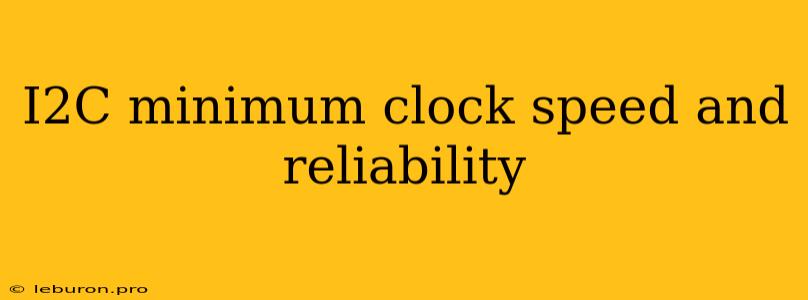I2C Minimum Clock Speed: Striking a Balance Between Speed and Reliability
The Inter-Integrated Circuit (I2C) bus is a ubiquitous communication protocol found in countless embedded systems, from simple sensors to complex microcontrollers. While the I2C protocol offers simplicity and flexibility, achieving reliable communication requires careful consideration of the clock speed, particularly the minimum clock speed. This article delves into the intricacies of I2C minimum clock speed and its impact on the reliability of I2C communication.
Understanding I2C Clock Speed
The I2C minimum clock speed is a crucial parameter that determines the fastest rate at which data can be transmitted over the bus. It is typically specified by the I2C device manufacturer and represents the slowest clock frequency at which the device can reliably communicate. This minimum clock speed is not simply a theoretical limit; it plays a critical role in ensuring reliable data exchange between I2C devices.
Factors Influencing I2C Minimum Clock Speed
Several factors contribute to the minimum clock speed of an I2C device:
- Device Complexity: More complex devices with intricate internal operations may require slower clock speeds to ensure accurate data processing.
- Data Rate Requirements: Devices that handle large amounts of data may necessitate lower clock speeds to accommodate data transmission without errors.
- Noise Sensitivity: Some I2C devices may be susceptible to noise, which can introduce errors at higher clock frequencies. Reducing the clock speed helps mitigate noise interference.
- Power Consumption: Faster clock speeds generally lead to higher power consumption. Devices with limited power budgets may have lower minimum clock speeds to minimize energy usage.
The Impact of Clock Speed on I2C Reliability
Setting the I2C clock speed too high can lead to several reliability issues:
Data Corruption:
The I2C protocol relies on precise timing for data transmission. If the clock speed is too high, the I2C device may struggle to meet the timing requirements, leading to incomplete data transfers or corrupted data.
Communication Failures:
Exceeding the minimum clock speed can cause communication failures. The device might miss data bits or interpret them incorrectly, resulting in communication errors.
Signal Integrity Issues:
At higher clock speeds, the signal rise and fall times become shorter, making the signals more susceptible to noise and distortion. This can lead to false transitions and unreliable data transmission.
How to Determine the Optimal I2C Clock Speed
To ensure reliable communication and maximize performance, the minimum clock speed should be carefully chosen. Here are some guidelines:
Consult the Device Datasheet:
The first and foremost step is to refer to the device datasheet. The datasheet will specify the minimum clock speed for each device, along with other relevant parameters.
Consider the Application:
Evaluate the specific requirements of your application. If the data rate is low and noise is minimal, a higher clock speed might be possible. However, for data-intensive applications or those operating in noisy environments, a lower clock speed may be preferable.
Experimentation:
In cases where the datasheet information is insufficient or the application has unique requirements, it may be necessary to perform experimentation. Gradually increase the clock speed and monitor communication performance to identify the optimal balance between speed and reliability.
Strategies for Improving I2C Reliability at Lower Clock Speeds
While reducing the clock speed can improve reliability, it can also reduce data throughput. Here are some strategies to mitigate the potential impact of lower clock speeds:
Optimize the I2C Bus Layout:
Proper bus layout is crucial for signal integrity. Keep traces short, use shielded cables, and minimize cross-talk between bus lines.
Use Pull-up Resistors:
Pull-up resistors help maintain a strong logic "high" level on the bus, reducing noise susceptibility and improving signal integrity.
Incorporate Bus Termination:
For long bus lines, termination resistors can help absorb reflections and improve signal quality.
Implement Error Detection and Correction:
In critical applications, consider using error detection and correction (EDAC) mechanisms to detect and correct errors during data transmission.
Conclusion
The I2C minimum clock speed is a critical factor in achieving reliable communication over the I2C bus. It is essential to understand the factors that influence this parameter and the potential impact of exceeding it. By carefully selecting the clock speed and employing appropriate design strategies, you can ensure reliable and efficient I2C communication in your embedded systems.
